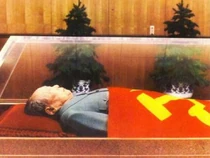
Biography
Mao Zedong, also translated as Mao Tse-tung, was a Chinese Communist revolutionary. He was the founding father of the People's Republic of China and governed as Chairman of the Communist Party of China from its establishment in 1949 until his death in 1976. He is also known as a theorist. He established Marxism–Leninism–Maoism or Mao Zedong Thought by collecting Marxist–Leninist theories, military strategies, and political policies. Mao's body was placed on display in the Great Hall of the People, and then was moved to Mausoleum.
Mummification
Mao died on September 9th, 1976, of Parkinson’s disease. After his death, Mao’s body was moved to a specious room where the temperature of the entire building was lowered to 500 F(100 C). The specialists permanently preserved the body by injecting twenty-two liters of formaldehyde within four to eight hours of death. After the injection, Mao’s face was bloated and his body was swollen. His skin was shiny and the formaldehyde oozed form his pores like perspiration. His ears were sticking out from his head at right angles. The embalmers were forced to cut a slit down the back of his jacket and trousers to allow them to accommodate his increased bulk. At midnight the morning of September 10, the embalmers placed the body into a crystal vacuum-sealed coffin. After a few days, Mao’s skin began to wrinkle and was removed from public display. Sometime after midnight on September 17, 1976, Mao’s body was taken in a minibus from the Great Hall of the People in Beijing to a clinic’s operating rooms. The specialists left Mao’s brain but removed viscera including heart, lungs, stomach, kidneys, intestines, liver, pancreas, bladder, gallbladder, and spleen, and then preserved viscera with formaldehyde. The visceral cavity was filled with formaldehyde-saturated cotton. A tube was inserted into the neck to allow them to replenish the formaldehyde at periodic intervals. The crystal coffin was filled with helium.
Studies
After a few weeks, Mao’s skin began to wrinkle and was removed from public display. Sometime after midnight on September 17, 1976, Mao’s body was taken in a minibus from the Great Hall of the People in Beijing to a clinic’s operating rooms in Maojiawan. Li Zhisui, one of the preservation specialists, inspected Mao’s body once a week for a full year. On September 17th, 1977, Mao’s body was entombed in the mausoleum. His vital organs were transferred to the huge vault beneath the public hall. The crystal coffin was installed on a platform which is an elevator, which descends to lower it form the viewing area. After that, a memorial service was held at Tiananmen Square.
Pathology
There were bluish bruises appearing in Mao’s body. The bruises were explained as “death patches”, that appeared about four hours after death. It had been caused by three large air bubbles in the left lung and pneumonia in both lungs
Additional Info
Mao was also a skilled Chinese calligrapher with a highly personal style, which is known as “Mao-style” or Maoti. In China, Mao was considered a master calligrapher during his lifetime. His calligraphy can be seen today throughout mainland China.
External Links
http://www.atlasobscura.com/articles/atlas-obscura-s-guide-to-communist-mummies https://books.google.co.uk/books?id=VP2JxzGGlNwC&pg=PA40#v=onepage&q=mao&f=false
References
Brumble, Sarah. Atlas Obscura’s Guide to Communist Mummies. Retrieved from http://www.atlasobscura.com/articles/atlas-obscura-s-guide-to-communist-mummies Christine, Quigley. Modern Mummies: The Preservation of the Human Body in the Twentieth Century. Retrieved from https://books.google.co.uk/books?id=VP2JxzGGlNwC&pg=PA40#v=onepage&q=mao&f=false
Yen, Yuehping (2005). Calligraphy and Power in Contemporary Chinese Society. Routledge. p. 2.
